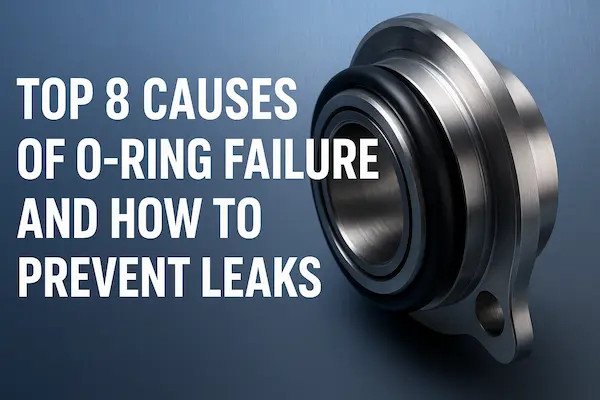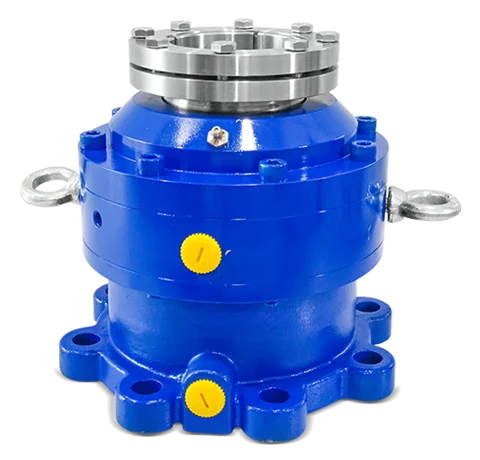Posted At: Jun 11, 2025 - 327 Views

Top 8 Causes of O-Ring Failure and How to Prevent Leaks
Introduction
An O-ring might look simple, but it plays a crucial role in maintaining tight, leak-free seals in pumps, valves, and mechanical systems. However, when an O-ring fails, it can lead to costly downtime, fluid leakage, and equipment damage.
Understanding the causes of O-ring failure and how to prevent them ensures reliable performance and extended seal life. Let’s explore the top eight reasons for damaged O-rings, along with prevention methods recommended by QM Seals.
1. Improper Installation
One of the most common causes of O-ring failure is poor installation. Incorrect handling, twisting, or stretching can cause surface cuts or nicks, leading to early leaks.
Prevention Tips:
Use proper lubrication during installation.
Avoid sharp edges on metal components.
Follow recommended gland design and dimensions.
Install using correct tools, not fingers or sharp objects.
2. Chemical Compatibility Issues
When an O-ring material is not compatible with the operating fluid, it can swell, crack, or harden. This chemical degradation often results in seal leakage or breakdown.
Prevention Tips:
Choose an O-ring compound suitable for the fluid — such as Viton® for chemicals or EPDM for water-based systems.
Check compatibility charts before material selection.
Replace O-rings at recommended service intervals.
3. Excessive Temperature
High operating temperatures can harden or soften the elastomer, causing cracks, shrinkage, or loss of elasticity. Conversely, extremely low temperatures can make the O-ring brittle.
Prevention Tips:
Select materials rated for your temperature range (e.g., FKM, Silicone, or PTFE).
Avoid sudden temperature fluctuations.
Ensure proper cooling and insulation in high-heat zones.
4. Compression Set
Compression set happens when the O-ring loses its elasticity due to prolonged compression. Once this happens, it can’t return to its original shape, leading to persistent leaks.
Prevention Tips:
Use compounds with low compression set properties.
Maintain correct gland depth and squeeze ratio.
Avoid over-tightening or excessive pressure.
5. Extrusion and Nibbling
Under high pressure, the O-ring can be forced into the clearance gap between metal parts, causing extrusion or nibbling damage on the edges.
Prevention Tips:
Use backup rings for high-pressure applications.
Reduce clearance gaps in the hardware.
Use harder materials (e.g., 90 Shore A or above) for high-pressure sealing.
6. Abrasion and Wear
Continuous friction between the O-ring and dynamic surfaces causes abrasion, leading to flat spots or grooves. This is common in reciprocating or rotating seal applications.
Prevention Tips:
Apply proper lubrication to reduce friction.
Choose wear-resistant materials like Nitrile (NBR) or Polyurethane (PU).
Inspect dynamic parts regularly for roughness or misalignment.
7. Improper Gland Design
Incorrect groove dimensions, surface finishes, or tolerances can put uneven stress on the O-ring, resulting in leak paths or premature seal wear.
Prevention Tips:
Follow ISO or AS568 gland design standards.
Maintain correct surface finish (usually 16–32 µin Ra).
Consult seal experts for application-specific design recommendations.
8. Environmental Factors
Exposure to ozone, UV light, or oxygen can cause surface cracks and degradation over time. These issues are often overlooked but can lead to bad O-rings that fail unexpectedly.
Prevention Tips:
Store O-rings in cool, dark, and dry environments.
Use ozone-resistant materials like EPDM or FKM.
Avoid unnecessary exposure to sunlight and air.
How to Identify a Damaged O-Ring
You can spot a damaged O-ring by inspecting:
Cracks, cuts, or flattened surfaces
Sticky or brittle texture
Swelling or discoloration
Leakage at the sealing point
If these symptoms appear, it’s time to replace the O-ring and review your system’s design or material compatibility.
Prevent O-Ring Leaks with Expert Solutions from QM Seals
At QM Seals, we specialize in precision-engineered O-rings and mechanical seals that deliver superior performance even in harsh industrial environments. Our sealing solutions are designed to prevent O-ring leaks, extend equipment life, and reduce maintenance costs.
Whether you need standard or custom sizes, QM Seals offers premium-grade O-rings made from NBR, FKM, EPDM, and PTFE compounds — all tested for durability and reliability.
Conclusion
Preventing O-ring failure starts with understanding the root causes — from installation errors to material mismatches. By choosing the right O-ring material and following best practices, you can prevent O-ring leaks and improve overall system reliability.
For premium O-rings and sealing solutions, trust QM Seals — your partner in precision sealing technology.
Frequently Asked Questions
1. What causes O-ring leaks?
O-ring leaks are typically caused by improper installation, chemical incompatibility, or material wear due to friction or temperature changes.
2. How do I prevent O-ring failure?
Use the correct material for your application, follow installation best practices, and regularly inspect seals for damage.
3. What happens if an O-ring fails?
A failed O-ring can lead to fluid leaks, pressure loss, contamination, or even equipment breakdown.
4. How long does an O-ring last?
With proper selection and maintenance, O-rings can last thousands of operating hours, depending on the system’s conditions.
5. Does QM Seals supply custom O-rings?
Yes, QM Seals manufactures and supplies custom O-rings and mechanical seals tailored for specific industrial applications.


